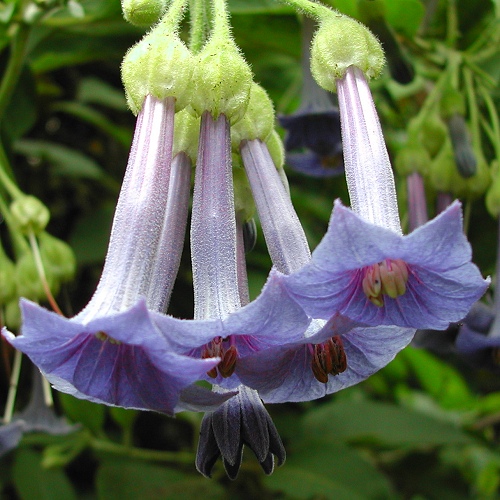Germinating the seeds
When to plant -- Plant your seeds when you receive them for best results. Getting started -- Use small containers or cups that have drainage holes. For soil, use a standard, well draining soil mix, such as 2 parts potting soil to 1 part perlite or coarse sand. Fill each container with soil, but don't pack it down. Add water until evenly moist. Place a seed on top, and sprinkle a thin layer of soil on top - about 1/8 inch (3 mm) Sprinkle some water on the top soil layer. Until the seeds sprout, ensure that the soil surface does not dry out. To maintain moisture it's usually best to enclose the pots in a plastic dome or bag. Leave it open a crack to allow fresh air in. You may need to drip some water on the soil every day or 2 to keep it moist. Keep the pots at about 65-75 degrees F (18-24°C). Avoid letting them get above 77°F (25°C) for prolonged periods. I recommend placing a minimum/maximum thermometer near the pots, especially if using a heating mat. Keep them in a bright spot, but not in direct sun. A fluorescent bulb kept 5 inches (12 cm) above the soil provides the right amount of light. The seeds should begin sprouting within 4 to 6 weeks, but allow up to 10 weeks for any slow ones to sprout, especially at cooler temperatures. Give your seedlings bright light, but avoid direct sunlight the first 4-6 weeks. A fluorescent lamp kept 4 inches (10 cm) away provides the right amount of light. I recommend growing them indoors the first few months. Watering - Once the seedlings are 3 weeks old, you may allow the soil surface to dry out, but keep the rest of the soil evenly moist (but not soggy). If your tap water is very high in minerals ("hard water") i recommend using bottled water or rain water. Repotting - When the plants are 2-3 months old, transplant them to a larger container. Transplant carefully to avoid letting the soil ball break apart, which can damage the roots. Watering the soil before repotting can help avoid this. For the first week after repotting, give no direct sun or liquid fertilizer. Feeding - The plants like soil of good fertility. Feed about every 2 months during the growing season with a slow-release fertilizer. If your potting soil contains fertilizer (check the label), your seedlings shouldn't need feeding the first 2-3 weeks. It's normal for an older leaf to occasionally turn yellow and drop, but if it seems excessive, your plant may need more nitrogen fertilizer. It can also be from overly dry soil down in the root zone. Keep in mind that the leaves normally drop each winter if temperatures are cool enough. Sunlight -- The plant likes mostly-sunny conditions, but in warmer conditions, it's best to give it some afternoon shade. Climate - The plant is happiest in moderate temperatures and cool nights. It's possible that consistently hot temperatures may stress the plant, particularly if nights are warm. In warmer conditions, give the plants afternoon shade, and don't place them near a wall where heat can collect. Keep the pots shaded to avoid overheating the roots. If this is not possible, use an oversized pot. They should be protected from frost, although a mature plant can probably survive a few degrees of frost. Over about 40% humidity is recommended. Indoors, if your humidity is too low, you may use an ultrasonic room humidifier, which you can get from thrift stores or home improvement stores. Pruning - You can remove any lanky branches, to help keep the plant looking tidy. Avoid removing too many branches at one time. Pests to watch for - Look for any insects that tend to affect your other plants. If you have any questions, feel free to email me. Have fun growing them! - Jeff Strange Wonderful Things
|
|||||||||


